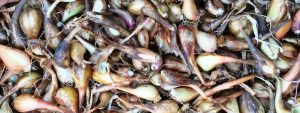
Sainte-Anne shallot
This shallot probably derives from the gray shallot
(Allium ascalonicum), a species native to Ethiopia which
includes a perpetual variety of fine flavor and
relatively short shelf life.
The Nordic selection
It brings together 10 varieties which have demonstrated their inestimable value for gardeners in these northern regions!
Take advantage of our selections which include seeds chosen by our team!
Home / Products / seeds / Bulbs, rhizomes and tubers / Sainte-Anne shallot – Organic

This shallot probably derives from the gray shallot
(Allium ascalonicum), a species native to Ethiopia which
includes a perpetual variety of fine flavor and
relatively short shelf life.
10.00$ - 175.00$
This shallot probably derives from the gray shallot (Allium ascalonicum), a species native to Ethiopia which includes a perpetual variety of fine flavor.
Cultivated in Quebec for probably more than 70 years, the Sainte-Anne shallot comes from a family garden in Sainte-Aurélie located in the Chaudière-Appalaches region. Its great particularity is to be perfectly perennial. Perennial and prolific, a single clove planted in July can yield ten the following year! It spreads slowly, hence the interest in dividing it each year to ensure the production of well-developed cloves. Our ancestors gave it the name Sainte-Anne shallot, because they got into the habit of planting it around July 26, a date which coincides with the feast of Sainte-Anne, patron saint of the province of Quebec. As our agricultural calendar has long used the religious festivals of the Catholic calendar as benchmarks, the period of dividing and drying of bulbs has been associated with Saint-Jean, patron saint of French Canadians and celebrated on June 24.
* presale From January 2024. Expedition shallots is made from July 20, 2024. Shipping costs are to be expected for this product.
This shallot probably derives from the gray shallot (Allium ascalonicum), a species native to Ethiopia which includes a perpetual variety of fine flavor.
Cultivated in Quebec for probably more than 70 years, the Sainte-Anne shallot comes from a family garden in Sainte-Aurélie located in the Chaudière-Appalaches region. Its great particularity is to be perfectly perennial. Perennial and prolific, a single clove planted in July can yield ten the following year! It spreads slowly, hence the interest in dividing it each year to ensure the production of well-developed cloves. Our ancestors gave it the name Sainte-Anne shallot, because they got into the habit of planting it around July 26, a date which coincides with the feast of Sainte-Anne, patron saint of the province of Quebec. As our agricultural calendar has long used the religious festivals of the Catholic calendar as benchmarks, the period of dividing and drying of bulbs has been associated with Saint-Jean, patron saint of French Canadians and celebrated on June 24.
* presale From January 2024. Expedition shallots is made from July 20, 2024. Shipping costs are to be expected for this product.
IMPORTANT: Presale from January 2024 // Shipping from July 20, 2024. Shipping costs are to be expected for this product.
Culture
Very easy to grow, the Sainte-Anne shallot is also very resistant to insects. Like most bulbs, it prefers well-drained soil, as excess moisture in the soil when thawing can lead to rot. During growth, water often, but in modest doses, because the roots are few and superficial. Plant the bulbs 30 cm apart each, leaving the tip of the bulb above ground to avoid rot.
The harvest
It is done from the beginning of spring with the appearance of the leaves. The bulbs and leaves have a particularly fine and fragrant taste during the month of May, becoming more and more pronounced in June. We use the cloves in the same way as we would a French shallot and the tender young leaves with delicate flavor are a pleasant substitute for chives or green onions.
Division of tillers
The tillers are divided during the week of June 24. You can then save the larger cloves to eat like onions and plant the smaller ones for the following year's harvest.
However, generations of gardeners leave some of their bulbs in the ground in June to allow them to produce noggins of flowers and bulbils. At the end of summer, the stems which bear the noggins are cut and left to dry. These dry noggins are then planted in the ground at the end of October and will produce delicious, tender and sweet shallots the following May.
Drying the bulbs
The bulbs take a few weeks to dry when spread out on a rack or newspaper, in the shade and dry. They are sufficiently dry when the stem has yellowed and the outer covering has browned.
How to use them in cooking
The smallest bulbs season broths and sauces and accompany meats, vegetables, shellfish, poultry and fish. You can also thread them with other vegetables on skewers and cook them on the grill. The long, crunchy stems divinely flavor salads, raw vegetables and marinades. Thinly sliced, they serve as a garnish for soups and baked potatoes. Fresh cloves cut into thin slices or minced are delicious in salad, dips, salsas and vinaigrettes.
We use cookies and other technologies to improve your experience on our site. By agreeing, you allow us to collect data such as your browsing behavior. You can withdraw your consent at any time, but this may affect certain functionality of the site. Your privacy is important to us.
